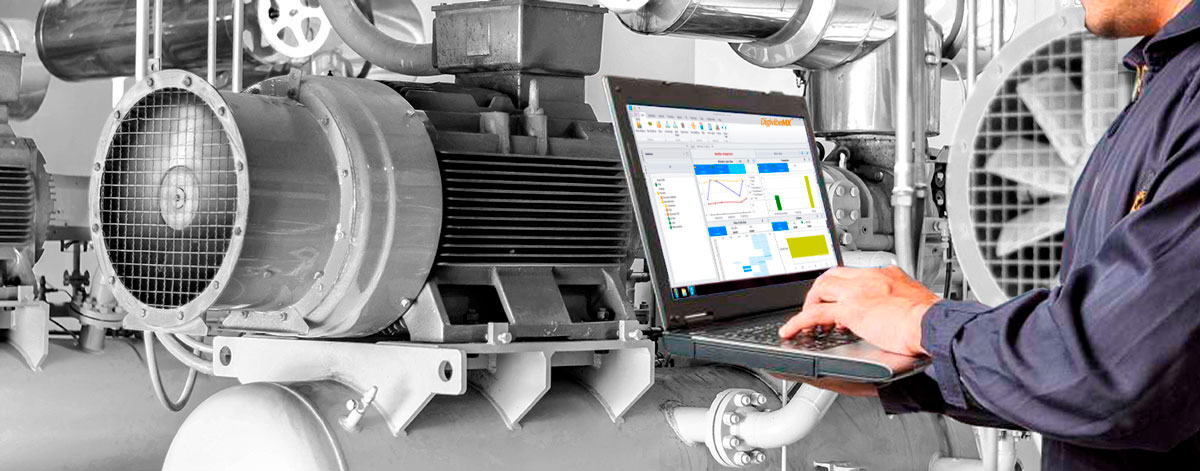Online Monitoring Systems | How to choose?
Table of Contents

What is Online Monitoring?
Online monitoring is the process of utilizing permanently mounted sensors to regularly check the condition of a machine. Online monitoring should consist of more than just vibration sensors. Given there are many different failure modes it is best to utilize a variety of sensor types to monitor the necessary variable to ensure early warning of failure.
Online monitoring systems can be wired, or wireless. With recent advances in battery and wireless transmission technology wireless online monitoring of machine, condition has become easier, less costly, and technologically advanced as compared to traditional wired solutions.
What is Vibration Analysis?
Vibration Analysis is a very useful and powerful tool used for identifying problem conditions within a mechanical system. It is very easy to identify problems in rotating machinery based on the known geometry of the rotating components of the system combined with the operating conditions. Comparing the Vibration Analysis signature of the system over time to previous readings or known patterns based upon established industry parameters and alarms can help plan and schedule maintenance.
Different types of Online Monitoring Parameters:
Periodic or Time-Based Vibration Analysis is completed using a portable instrument. There are several different types of portable instruments including overall meters, route-based data collectors, multi-channel data collectors and more. To learn more about Vibration Data Collectors check our article Choosing the Best Vibration Analyzer.
Online Monitoring Vibration Analysis utilizes a system of permanently mounted sensors to enable the recording of vibration measurements without human intervention. There are two main types of online vibration monitoring. Online Monitoring and Surveillance Monitoring.
Online Vibration Monitoring Systems:
Online Monitoring Vibration Analysis systems are protection systems. These systems are typically wired systems with permanently mounted sensors used to protect equipment. Online monitoring protection systems adhere to the API (American Petroleum Institute) 670 industry standard. These systems are very expensive to purchase, install, and maintain compared to their Reconnaissance Monitoring Counterparts.
Reconnaissance Monitoring Vibration Analysis systems are vibration surveillance systems. These systems are gaining overwhelming popularity as the cost of technology continues to decline.
These systems have also traditionally been wired but with new advances in technology are quickly adopting a variety of wireless options. Reconnaissance monitoring vibration systems are not API protection systems, they are however very well suited for most rotating mechanical equipment.
Wired Vibration Analysis Online Monitoring:
When selecting the right system for your application some key factors should be taken into consideration. Is the area the machine that requires monitoring in a hazardous atmosphere? Or surrounded by fluid? If so then there are few wireless options available and wired Vibration Analysis sensors are likely to be the only option for the application.
Similarly, if the machine is critical as determined by the potential for failures impact of health, safety, environment, quality, and operations and maintenance costs…then again wired Vibration Analysis solutions can be selected if the equipment can meet or exceed the technical requirements. To understand better the technical requirements consider reading our article Vibration Analysis Basics.
Wireless Vibration Analysis Online Monitoring:
When evaluating wireless vibration analysis systems all the same considerations above should be contemplated. Additionally, one should consider:
Network Topology: Is the system being considered a point-to-point or mesh wireless system? Point-to-point systems require direct communication between each sensor and their designated receiver. Mesh wireless sensor systems all sensors to communicate with each other or to communicate with a combination of repeaters and gateways to achieve successful signal transmission.
Communications Protocol: What communications or combinations of communications protocols does the wireless system use? Could this protocol interfere with other signals or processes within the facility? Does the protocol or combination of protocols achieve the desired data transfer requirements?
There are many different types of communications protocols to consider including but not limited to Bluetooth, Bluetooth Low-Energy or BLE, 900MhZ, Cellular, Wi-Fi, Ethernet, Controls Systems and more. For Wireless vibration monitoring systems, the newest Bluetooth Low-Energy or BLE standard is by far the best. Bluetooth Low-Energy affords very low power consumption, very high data transfer rate, and very long achievable data transfer distance.
Power Requirements: As with any system it is very important to understand what requirements the system will have for power. In many industrial environment’s 24VDC is common control power and 110/220VAC is common utility power. Consumption is not the only consideration in battery devices but also permanently powered devices like wireless receivers. A new and emerging standard is 5VDC which so happens to be USB port power. This new standard is by far the most universally accepted, deployed, and best option for consumptions.
For battery powered devices like wireless sensors, it is truly a balance of your needs for machine reconnaissance and battery life. Wi-Fi, 900MhZ, Cellular, and Traditional Bluetooth are not battery friendly.
Bluetooth Low-Energy or BLE can achieve 4-6-year battery life with a 3.7V 1/6th D-Cell Battery and still take 3200 lines of resolution readings 8 times per day. Conversely, the same battery can achieve a 9 month to 1-year battery taking the same resolution readings every 10 minutes.
How Accessibly is your Vibration Analysis Data?
Open Databases: It’s your data… databases should be totally open. You should be able to access your data without worry or penalty as a result of proprietary technology. With our Phantom systems, you can access your database with any SQL or MySQL based software, giving you the option to link them to other software like Scada, Historian, and more.
Are you a developer? Use our vibration monitoring sensors on your own system. We offer APIs for developers to integrate Phantom to their own framework. The architecture of Phantom’s APIs will allow you to access and control an infinite number of sensors and gateways in order to configure alarms and recording times.
What Sensor Types are Available?
It’s not only about Vibration Analysis: while vibration analysis is a powerful tool, it is not the sole indicator of the early stages of failure. It is very important to consider other variables that should be measured like temperature, speed, current, and other process variables like pressure and flow. The latest technology like that found in the Phantom System delivers the widest variety of sensor input types including a wireless general purpose sensor.
Machine Learning Diagnostics and Artificial Intelligence?
Can the sensors and the underlying technology support the latest IIoT (Industrial Internet of Things 4.0) protocols? ISO and Bearing Fault Frequency alarms are no longer enough. With the Phantom Online Wireless Monitoring, the system will learn the behavior of your machine and its operating parameters measured by the sensors to determine what is normal and alert you when something is not normal.
Phantom® includes 3 types of learning:
RMS: Is the simplest learning process (but not less reliable). During this period, Phantom will track the RMS of velocity, acceleration, and acceleration envelope to define later a behavior.
Envelope alarms: During the learning process, our online monitoring system will evaluate each of the spectra to determine a normal behavior in each of the corresponding frequencies. So, in the future, Phantom will know when an unknown frequency appears or any other known frequency increases in amplitude.
Preset Bearing and Gearboxes faults: Emphasis is made for tracking preset bearing and gearboxes faults.
Conclusions:
As you can see there are many variables one should consider when evaluating and ultimately selecting a wireless online monitoring system for asset condition assessment. Not all sensors or software are created equally so consider the best options for your use case, and make an informed choice.
Dr. Michael Howard, is an American entrepreneur and Air Force veteran with a remarkable career in the predictive maintenance industry spanning over 30 years, and a variety of industrial sectors, including industrial manufacturing, reliability engineering, and instrumentation development and design organizations. Dr. Howard is a graduate of Excelsior University, Capella University, and New Charter University with degrees in Electro-Mechanical Engineering, Leadership and Organizational Management, and Engineering Management.
As the CEO of Erbessd Instruments, he leads strategy, sales, marketing, and operations in English-speaking markets. He is a certified reliability engineer, certified maintenance and reliability professional, and category III vibration analyst. Michael is a passionate advocate for wireless instrumentation, video deflection, and the Industrial Internet of Things (IIoT).
ERBESSD INSTRUMENTS® is a leading manufacturer of Vibration Analysis Equipment, Dynamic Balancing Machines, and Condition Monitoring with facilities in Mexico, the USA, the United Kingdom, and India.

Wireless Current Sensor
EPH-C31 | Erbessd 4-Phase Current Sensor-
-
Measures 4-Phase current simultaneously
-
Sends every 5min the max. value of a 15s reading
-
Compatible AC Split-core Clamps (50A, 100A, 250A, 500A)
-
Configurable Alarm value
-
Standby mode and long battery life
-
2 Replaceable LiON AAA bateries
-
IP67 Protection
Wireless Universal Sensor
EPH-MT | Erbessd Vibration, Current and Temperature-
-
10kHz FMax
-
Full waveform and spectrum data
-
Resolution Lines: 6400
-
Measures 3-Phase curent simultaneusly
-
Compatible AC Split-core Clamps (50A, 100A, 250A, 500A)v
-
2 Temperatures Channels
-
Range of -210°C to 1800°C
-
Connect any type of Thermocouple
Wireless Temperature Sensor
EPH-T25 | Erbessd Thermocouple sensor-
-
Range of -210° to 1800° C
-
Measures temperature for object and ambient
-
Connect any type of Thermocouple
-
Configurable Alarm value
-
Standby mode and long battery life
-
IP67 Protection
-
2 Replaceable LiON AAA bateries








